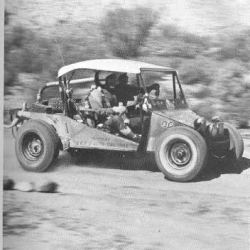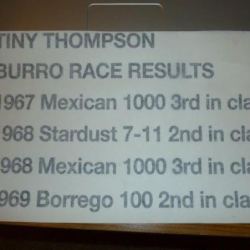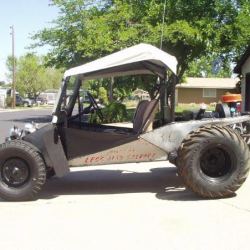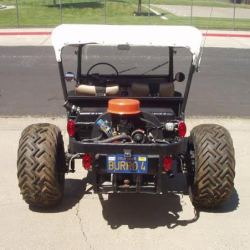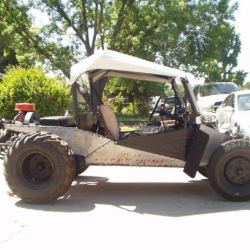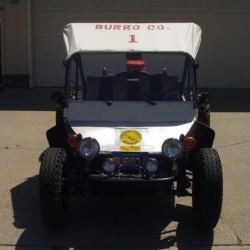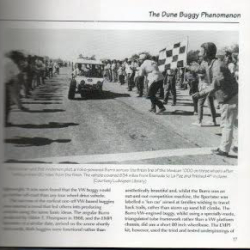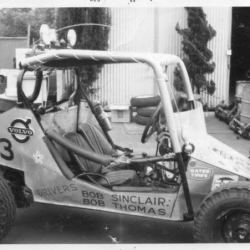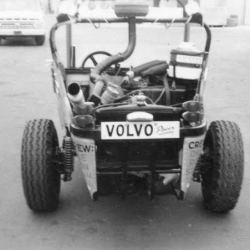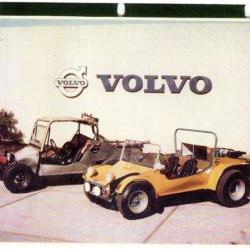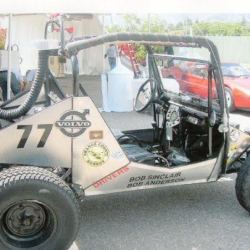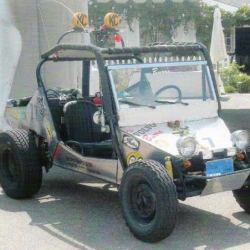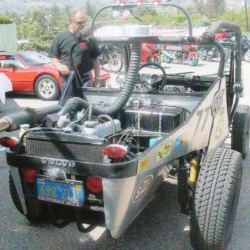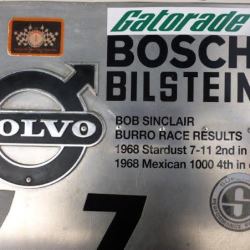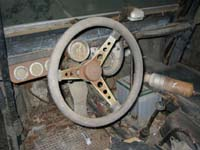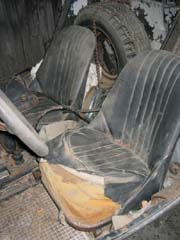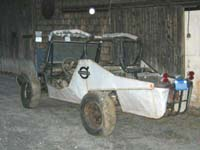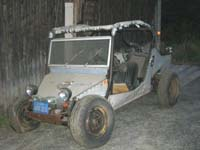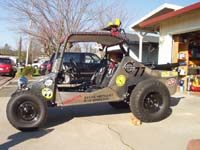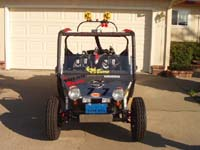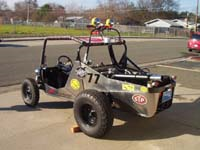TLR had the pleasure of taking the Green Booger to one of our largest local car shows in late 2012, the Auburn Cruise Night finale. You can read more about that HERE.
At this car show, we saw an interesting little race car, and met the pretty cool owner of it. Steve Heckert was kind enough to give us a history on his cute little buggy, and he actually still races it in NORRA in the vintage class.

Steve was a wealth of knowledge on the Burro cars, and was happy to provide TLR with rare information and photos pertaining to them, including even vintage VORRA photos from the 1970’s. We have gained his permission to share them with you, as he is happy to spread the good word on the Burros, and we hope you enjoy reading about their history. Please note – all photos and Burro documentation has been generously provided by Steve Heckert.
From Steve: “If you have seen the 1968 Mexican 1000 Wide World of Sports DVD or video race coverage, this is the #1 Burro taking off from the starting line with Jim McKay talking to the drivers Chuck Andrade & Gary Weers. This Burro is shown a few times in that coverage.”
Click on the photos for a larger version.


For your reading pleasure, articles from Dirt Sports Magazine and Sand Sports Magazine (these are in PDF format):
– Legends Returning to Baja
– History of the Dune Buggy – The Burro, by Michael Sommer (Page 1)
– History of the Dune Buggy – The Burro, by Michael Sommer (Page 2)
– History of the Dune Buggy – The Burro, by Michael Sommer (Page 3)
– History of the Dune Buggy – The Burro, by Michael Sommer (Page 4)
From Steve: “Here are pics of my 1968 Volvo Powered Burro racer. This is the one that I told you finished the 1968 Mexican 1000 on three wheels. The black & white pics are from 1968 & 69. The pic of the two Burros sitting in front of the Volvo Building was taken in 1969 at the Volvo Headquarters. They are old race buggies but they are part of how off road racing came to be.”
The following article was published in 2006 on the now defunct website vintagerally.net, and written by Bob Sinclair:
Prior to becoming President/CEO of Saab-Scania of America in 1979, Bob Sinclair was employed at Volvo’s California office beginning in 1967. While there, he tried his hand at the new sport of off-road racing, in a Burro buggy powered by a Volvo engine, of course.
Bob was recently re-united with the restored Volvo Burro. He shares his story here.
The Rebirth of the Volvo Burro
March 2006
I got phone call back in 1967, not long after Anne and I and moved from the east coast to Southern California with our growing family and I took up my new job with Volvo’s western U.S. operations. It was John Christy calling, Editor-in-Chief of MOTOR TREND. John asked it I planned to go to the race at Tijuana that weekend. A race at Tijuana?
He said there was going to be an offroad race weekend from Tijuana, Baja California, Mexico, all the way to La Paz some 1,000 miles to the south. Since I was aware there was no paved road the length of Baja, that was a real surprise. I hadn’t heard anything about it, but naturally a few days later I headed for Tijuana to watch the start of the race. It was the very first Baja 1000, and started at the Plaza Monumental bullring on the seaside south of the city. Since no one was sure what sort of car would be best suited for a 1,000 mile offroad race, the variety that showed up at the starting line was mind-boggling.
A few months later, famous automobile photographer and longtime friend Tom Burnside phoned from New York. He said he had an assignment to do a photo story about the west coast dune buggy phenomenon for TRUE (a men’s magazine of the era), and wondered if I knew anything about them. I definitely did not. Tom arrived a few days later. He spent some days traveling in southern California photographing dune buggies and the small shops building them, the best known being Bruce Meyers’ Meyers Manx operation. A few days before flying back to New York Tom paid us a visit and showed me the proof sheets of his photos. I was intrigued by the Burro. It was built in Santa Ana, and was powered by a Volkswagen engine mounted in the rear.
The next day Tom and I drove to the Santa Ana, where I checked the place out and asked if they thought it would be feasible to build a Burro with a rear mounted Volvo engine. It didn’t seem like a good idea for me, head of Volvo’s western U. S. operations, to be seen in a plaything powered by a VW engine. Converting the design to replace the air cooled four cylinder transverse Volkswagen engine with an in-line water cooled four cylinder Volvo engine was no small challenge, but with a few modifications to the standard Burro chassis, it looked like it would work. Construction of the Volvo Burro soon began.
After using it as a family plaything for a while, I decided to go racing. I entered the car in an offroad race starting in the desert a few miles from Las Vegas. It was called “The “Stardust 7-11.” Entered as drivers were the builder of the car, Hilder “Tiny” Thompson, and his friend Les Choat, who from his wrecking yard in Compton supplied the used VW transmissions, suspension components and other Volkswagen parts used in building all Burro dune buggies. They did quite well, finishing 2nd in class and 13th overall. Soon after, a feature story about the Volvo Burro appeared in the September 1968 issue of ROAD & TRACK magazine.
The car had taken quite a beating during the race, and needed strengthening of the frame and suspension bits. That done, I decided to enter it in the 2nd running of the Baja 1000 in October of 1968 – this time with me in the driver’s seat. My bosses at Volvo over in Sweden were not amused.
The effort was reasonably successful, considering I had no experience whatever as an offroad race driver. The Volvo Burro was among the race leaders throughout most of the long race, but when we finally left the dirt and picked up the paving near Villa Constitution (now known as Ciudiad Constitution) about 60 miles from the finish line, I found myself falling asleep at the wheel. I had driven for more than twenty hours through incredibly rough terrain. Weary in the extreme, I pulled off the road and told my co-driver, Bob Anderson, he would be driving the rest of the way. “Just take it easy,” I told him. “We’re doing great. Just keep it on the road.”
Apparently Anderson was also road weary, for the next thing I knew I was lying in the dirt, regaining consciousness after being thrown violently from the car. Friend Anderson had dozed off, run off the paving and up a bank, rolling the car. The impact tore off the left front wheel and parts of the suspension.
What to do? When we got the car turned right side up, it seemed otherwise intact. However the left front corner, with the wheel missing, was resting on the paving. To deal with this, we moved the smaller front wheels to the rear, and put one of the big rear ones on the right front corner, thus gaining a bit more clearance and lifting the left corner off the road. The car could be driven on just three wheels! We could run quite fast through left bends, but were forced to crawl through right turns when weight shift had the left corner dragging on the asphalt. We had no brakes, of course, having lost the brake fluid in the crash.
Running on three wheels, we crossed the finish line in 27 hours, four minutes – 4th in the Modified Two-Wheel-Drive class. There were 243 entries in the race. 160 of them managed to finish within the 50 hours cutoff time. We were the 12th car to take the checkered flag, and made history by being first to finish a Baja 1000 on three wheels. Photos of our finish ran in newspapers and magazines around the world. This publicity tended to assuage the irritation of my bosses, of course.
The following October I again entered the car in the Baja 1000, this time with Bob Thomas, Auto Editor of the Los Angeles Times, riding shotgun. Unfortunately, I managed to crash Big Time a hundred or so miles out, effectively ending our race.
When Anne and I moved east with Volvo in 1978, not long before I resigned to join Saab, I shipped the Volvo Burro to our eldest son Bob in Vermont. My thought was that he as an automotive mechanic could rebuild it and have some fun playing out in the woods. Unfortunately, after he started on the project things came to a halt. For around 20 years the car sat partially dismantled, exposed to the Vermont weather.
In August of 2003 I was contacted by Steve Heckert, who told me he saw the Volvo-powered Burro when he was a small boy. His father had raced a Burro with a Volkswagen engine in the early offroad races, and Steve had been fascinated by Volvo Burro. He said he had been looking for it for quite a while, and that if it still existed he hoped to buy it and restore it to its condition as raced back in 1968. We went back and forth a few times, and I eventually cut him a deal; really more or less a giveaway. Steve had the remains of the car trucked across the continent to his home near Sacramento. He then spent a year or so on an incredible restoration of the remains he had acquired.
The images which follow show the Volvo Burro as it was when Steve got it from me; how it looked after his truly magnificent restoration; then how it looked recently while on display at the National Automobile Museum in Reno NV (the Harrah’s collection) as part of a group of historic offroad race vehicles.


Bob Sinclair
Casa Sueño
Santa Barbara CA
(Note: The Volvo-Burro was featured in a story in the Sept. 1968 issue of Road & Track magazine.)

